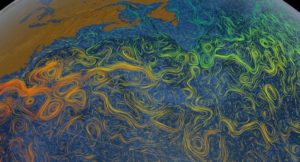- ...
Postgraduate Studentships - Search for funding opportunities.
Postgraduate Studentships - Search for funding opportunities.

Ocean flows coloured with sea surface temperature data (Credit: NASA/Goddard Space Flight Center Scientific Visualization Studio)
Mr Alan Williams
Media & Communications Officer
20 May 2019
Scientists have developed a new approach to describe the behaviours of microscopic marine larvae, which will improve future predictions of how they disperse and distribute.
A study by the University of Plymouth and the National Oceanography Centre, published in Proceedings of the National Academy of Sciences of the United States of America, abandons previously used methods to reveal new insights into larval behaviour in the ocean through reverse-engineering.
Computer simulations of the ocean are commonly used to predict how animals and plants move through water, an approach known as biophysical modelling.
The models combine in-depth knowledge of ocean currents with predictions of how larvae may behave and respond to environmental and biological cues such as light, gravity or pheromones.
These factors lead to changes in how they are distributed throughout the water column, and understanding this is especially important as many marine organisms are weak swimmers and rely on ocean currents – which reduce in speed and change direction with depth – to help them move.
Previously, researchers have described larval behaviour by scaling-up laboratory observations – for instance, programming simulated larvae to swim up and down in the water column in response to light cues – but since little is known about how effectively larvae respond to these cues in nature, it can result in the models failing to accurately predict dispersal.
The new research allows scientists to predict the direction and speed that larvae would have to swim for models to best match the patterns observed in nature, without knowledge of the mechanisms of their movement.
The study was led by PhD candidate Molly James and Associate Professor in Marine Ecology Dr Antony Knights, from the University of Plymouth’s School of Biological and Marine Sciences, and they found the swimming behaviours of larvae necessary to replicate natural patterns were markedly different to those suggested by laboratory studies.
They believe this ground-breaking method for assessing larval behaviour – which can be applied to any species with a dispersive larval phase – will dramatically enhance our understanding of how the tiniest lifeforms disperse in marine, freshwater and even terrestrial environments.
Find out more about the Plymouth’s School of Biological and Marine Sciences here

Postgraduate study opportunities at University of Plymouth About us At the University of Plymouth, we are proud to be one of only a select number of ...
Sign up to Postgraduate Studentships
Sign up to compare masters
Thanks for making your selection. Click below to view your comparisons.